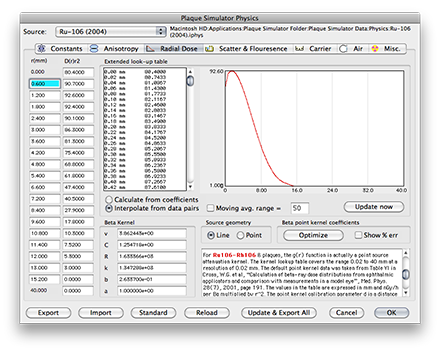|
For Ru106-Rh106 β plaques, the g(r) function is actually a point source attenuation kernel. The kernel lookup table covers the range 0.02 to 40 mm at a resolution of 0.02 mm. The default point kernel data was taken from Table VI in Cross, W.G. et al, Calculation of beta-ray dose distributions from ophthalmic applicators and comparison with measurements in a model eye, Med. Phys. 28(7), 2001, page 191. The values in the table are expressed in mm and nGy/h per Bq multiplied by r2. The point kernel calibration parameter d is a distance offset into this attenuation kernel. You may also elect to generate the beta kernel using Cross's formula and parameters v,C,R,k,b,a (see the Dose Constants tab) and to further optimize those parameters for a better fit the tablulated data. Cross's Monte Carlo derived point kernel is now Plaque Simulator's default because it is conceptually simple, it has been compared to measurement, other Monte Carlo codes, and empirical expressions derived by Cross, and it yields dosimetric results a few percent closer to BEBIG's central axis calibration measurements than the earlier MIRD formalism.
You may still elect to use the earlier MIRD formalism for Ru106 which was calculated from the Fβ (r/r90) scaled absorbed-dose distribution data in Table 12, MIRD pamphlet 7, 1971, page 20, according to the equation:
- g(r) = Fβ / (4πρ r2 r90) for r/r90 <= 1.8
- g(r) = 0 for r/r90 > 1.8
where ρ (g/cm3) is the density of the medium and r90 is the 90 percentile distance. The 90 percentile distance is the distance in mm from the source within which 90% of the energy is absorbed.
|

|